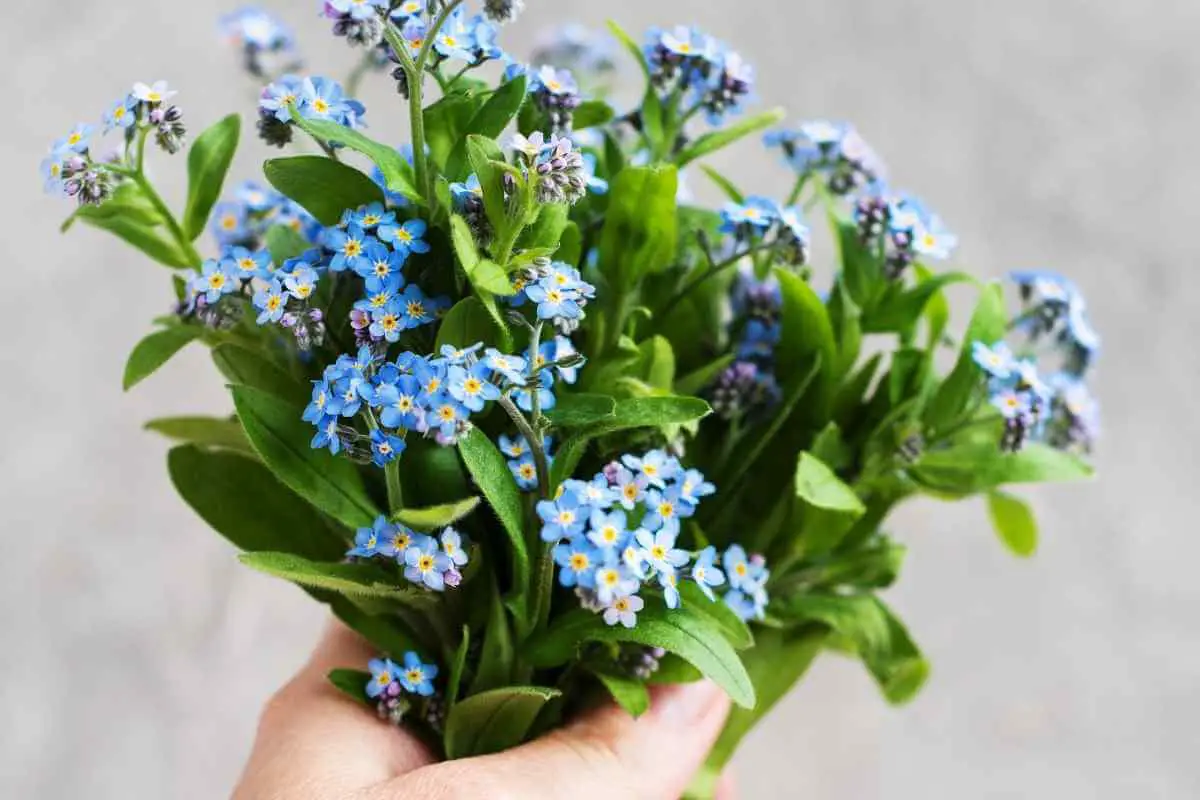Herbs are actually a lot more versatile than you might think!
In case you weren’t quite sure, an herb is a plant whose leaves, seeds, or flowers are used for medicine, fragrances, or flavorings for food.
When you envision herbs, you may not see bright beautiful flowers, but in fact, many herb varieties flower magnificent colors and specifically blue flowers!
Although there are some more obscure herbs with blue flowers, here are the top 5 you will definitely want to plant in your backyard or even in planters in your home for wonderful useful herbs and the beautiful blue flowers they produce.
- Sage
- Forget-Me-Nots
- Borage
- Hyssop
- Rosemary
If you are interested in planting your own herbs and want to know which ones will not only be useful in your life but also beautiful in your garden, we have just the article for you!
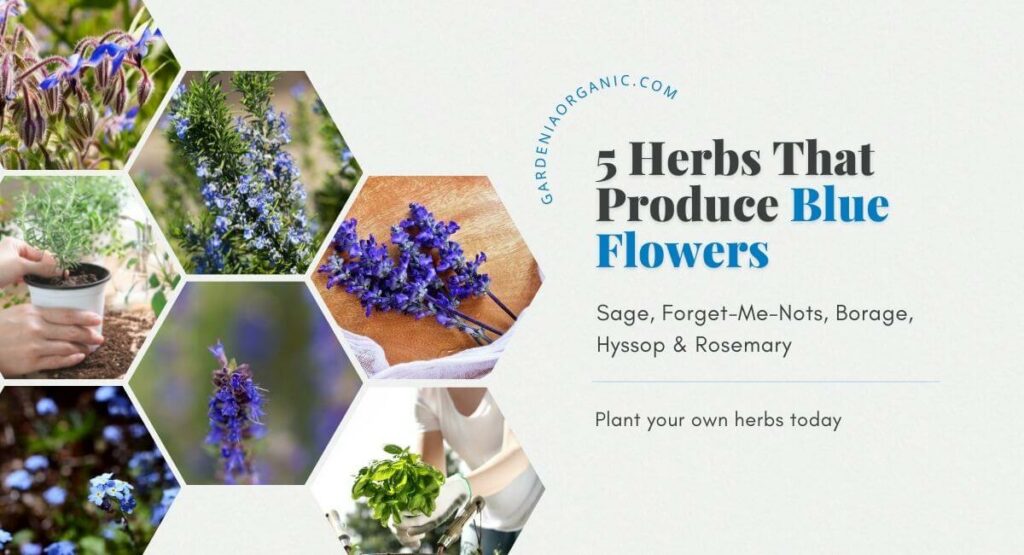
What You Will Learn: We are going to go through each of these wonderful herb varieties and find out what they can do for you, as well as what their flowers will look like and when you can expect them to bloom.
1. Sage: The Blue Healer
Blue sage, as it is often called, is and has been an extremely popular herb for centuries because of its healing properties.
Today, people often use dried sage as a cleanser of spirits, specifically when moving into a new space.
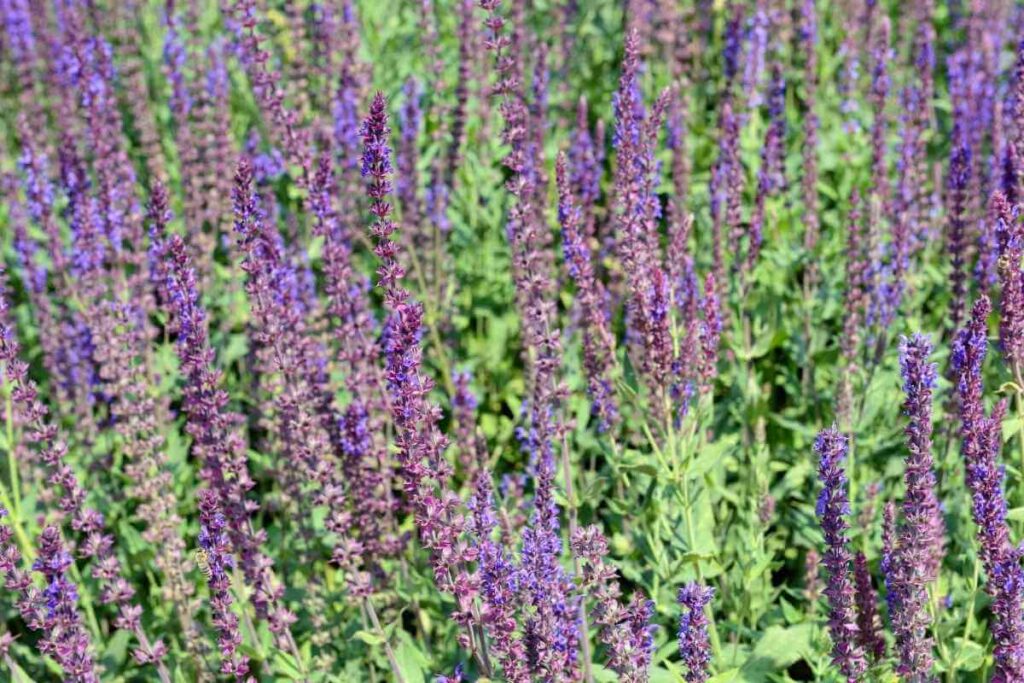
Even if you don’t believe in using herbs to get rid of dormant ghosts, sage is delicious! You can often find it in the herb section of your local supermarket as it is recommended in several culinary meals.
But the absolute best part of sage has to be its fragrance!
The smell is wonderful and if you choose to grow it in a pot on your windowsill or in the backyard, the aroma will engulf you whenever you pass by.
When grown from seed:
- Sage will usually take about two years before its ready to flower.
- After that, it will likely bloom gorgeous blue flowers at the beginning of every summer.
If you want to try to spot sage flowers, they typically look very similar to lavender.
They grow in small trumpets out from the stem to create a long skinny cone. All you really have to do is smell the air, and the scent will lead you right to them.
2. Forget-Me-Nots: The Gift that Keeps Giving
Do you ever wonder why these alluring plants are called forget-me-nots?
Well, it’s because their seeds can lay ungerminated in the ground for years, essentially being forgotten, until one day they sprout up, and two years later they will produce delightful blue flowers.
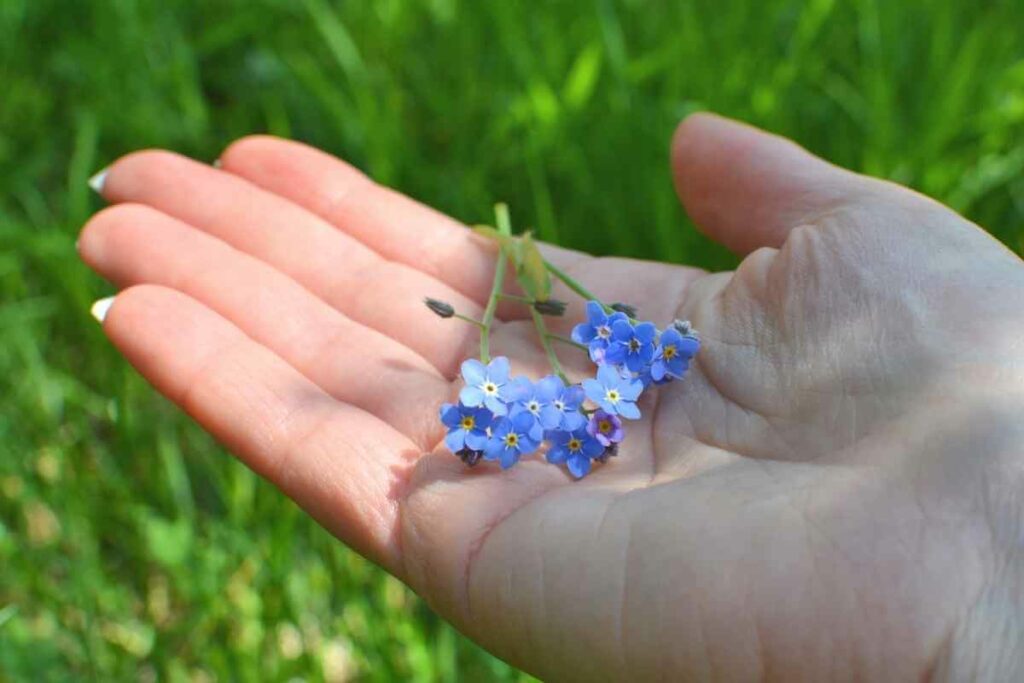
While some botanists say that you can eat forget-me-nots, they do have traces of a chemical that can harm the body if ingested in excess.
They may be better to use occasionally as a decoration for a cake or salad, as opposed to a constant part of your diet.
They also have some medicinal properties, as they can tighten the tissues on open wounds. However, if you are not looking to use them as such, they are still beautiful plants to have in your home.
Beautiful Herbs: The tiny blue flowers grow abundantly from each plant, creating a blanket of deep or light blue across your backyard.
3. Borage: The Cucumber’s Cousin
While the borage herb isn’t quite as robust as a cucumber, it produces a similar flavor and scent and is a favorite addition to the Mediterranean diet, as that is where it primarily grows.
It can be used:
- in salads
- with cold beverages
- or even cooked with other various greens
Borage also requires no patience, as if planted from seed, it will be able to bloom after only eight weeks if the timing is right.
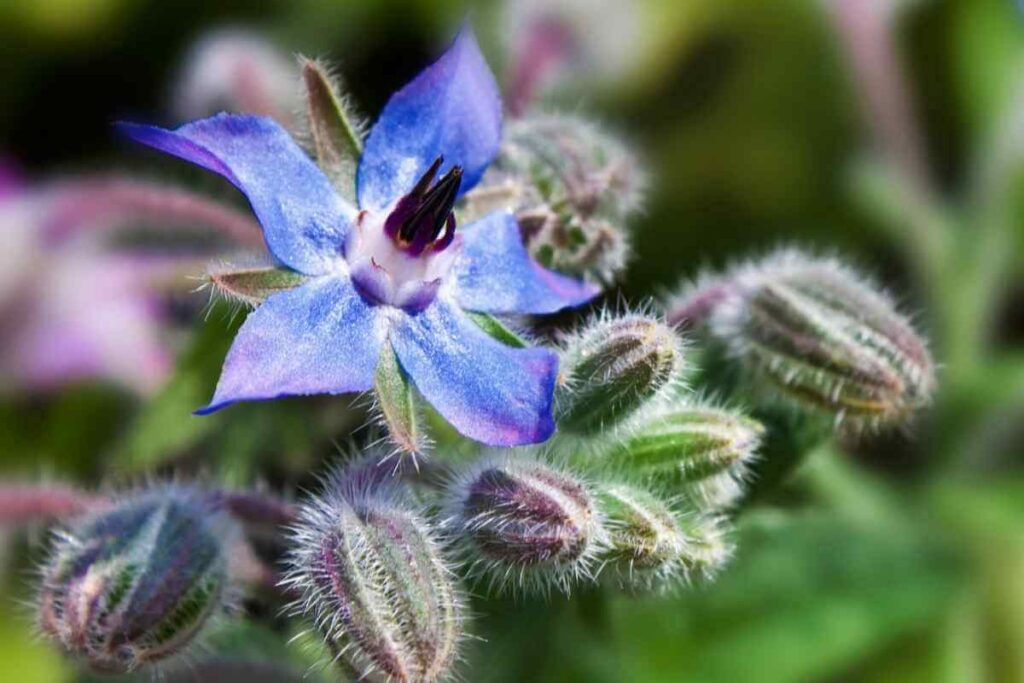
And shortly after they do flower, you may have a new family of honeybees pollinating your garden as they often flock towards borage.
Borage’s bright blue and star-shaped flowers will bloom every June to August, but be warned that borage can grow quite tall, up to 3 feet high!
So even though you may enjoy the annual bloom, they may start to take up a big space in your backyard or home garden.
4. Hyssop: Delicious to You; to Bees!
Next, we have another wonderful herb that is native to the Mediterranean which produces violet-blue flowers every year!
Hyssops will actually germinate within the first two weeks of sowing and then flower that very same year between the late summer and early fall months.
Besides its beauty, hyssop is well-known for its oily leaves which produce a sweet, spicy, and smooth chartreuse-like flavor that is wonderful to add to sauces, soups, and almost any meal.
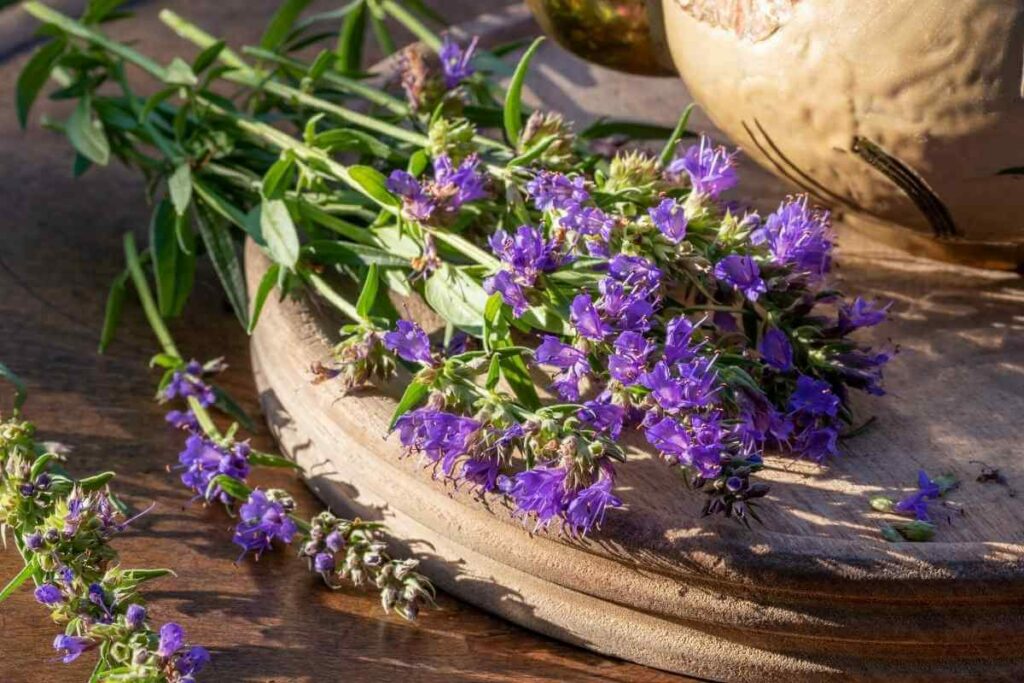
It can also grow to about two feet high, almost as large as the borage! So be careful when planting that you allow it plenty of space to flourish.
A great thing about hyssops is that they are wonderful pollinators!
Bees and butterflies will come from all over to visit this herb’s blue flowers and will therefore spread the pollen throughout your garden.
If planted from seed, your hyssop plant will likely bloom about 85 days later, so you won’t even have to wait very long to enjoy these magical flowers.
Take a Closer Look: To spot a blooming hyssop plant, it may be hard to differentiate the blue flowers from those of the sage plant, but you can tell a slight difference as they are more “spikey” and generally fuller.
5. Rosemary: Good for the Mind, Good for Lasagna
Rosemary is one of the most recognizable herbs as we often use it for Italian cooking!
It goes great with:
- pasta
- lasagna
- roast potatoes
- soups
- and more
But you may not have realized that it has lovely blue flowers and is a great scent for memory enhancement.
Rosemary essential oil is often recommended to use in your oil diffuser while studying or trying to learn something new as it helps retain information in the brain, and it smells amazing!
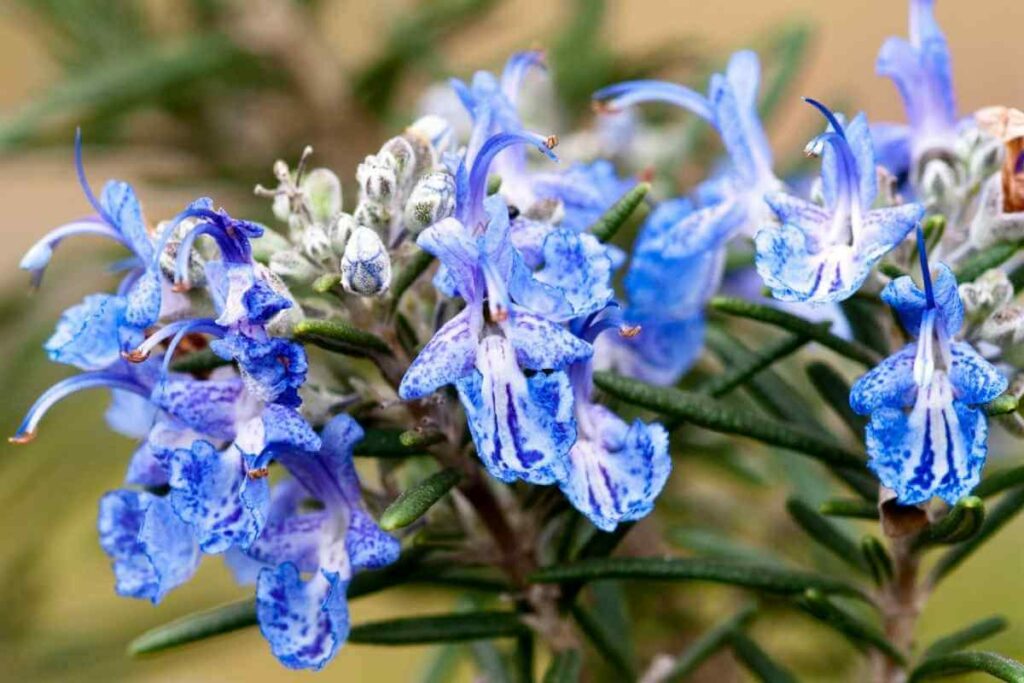
If you decide to grow rosemary, it will do well in both potted plants and in your back garden, so you can enjoy its flavor, scent, and even its medicinal properties.
In addition to all these wonderful assets, rosemary also blooms spectacular blue flowers twice each year!
You will most likely see rosemary’s small blue flowers amongst the herb stalks in the spring and then again in the early summer.
There is a chance that your rosemary might have trouble blooming; to ensure your rosemary plant flowers, ensure it has plenty of sunshine and minimal pruning in the spring months.
Final Thoughts
Herbs are easy and exceptionally helpful plants to grow anywhere in or around your home.
They are well known for being resilient and are not exceedingly difficult to care for.
While of course, they each contain a variety of qualities that can enhance both your food and your health, you may not have known that they can also produce beautiful ornamental flowers that will brighten up your home and your day!
These five herbs with blue flowers are certainly a few of our favorites, and you can easily add a few other herbs with flowers of every color in order to make your yard or windowsill colorful and useful.
